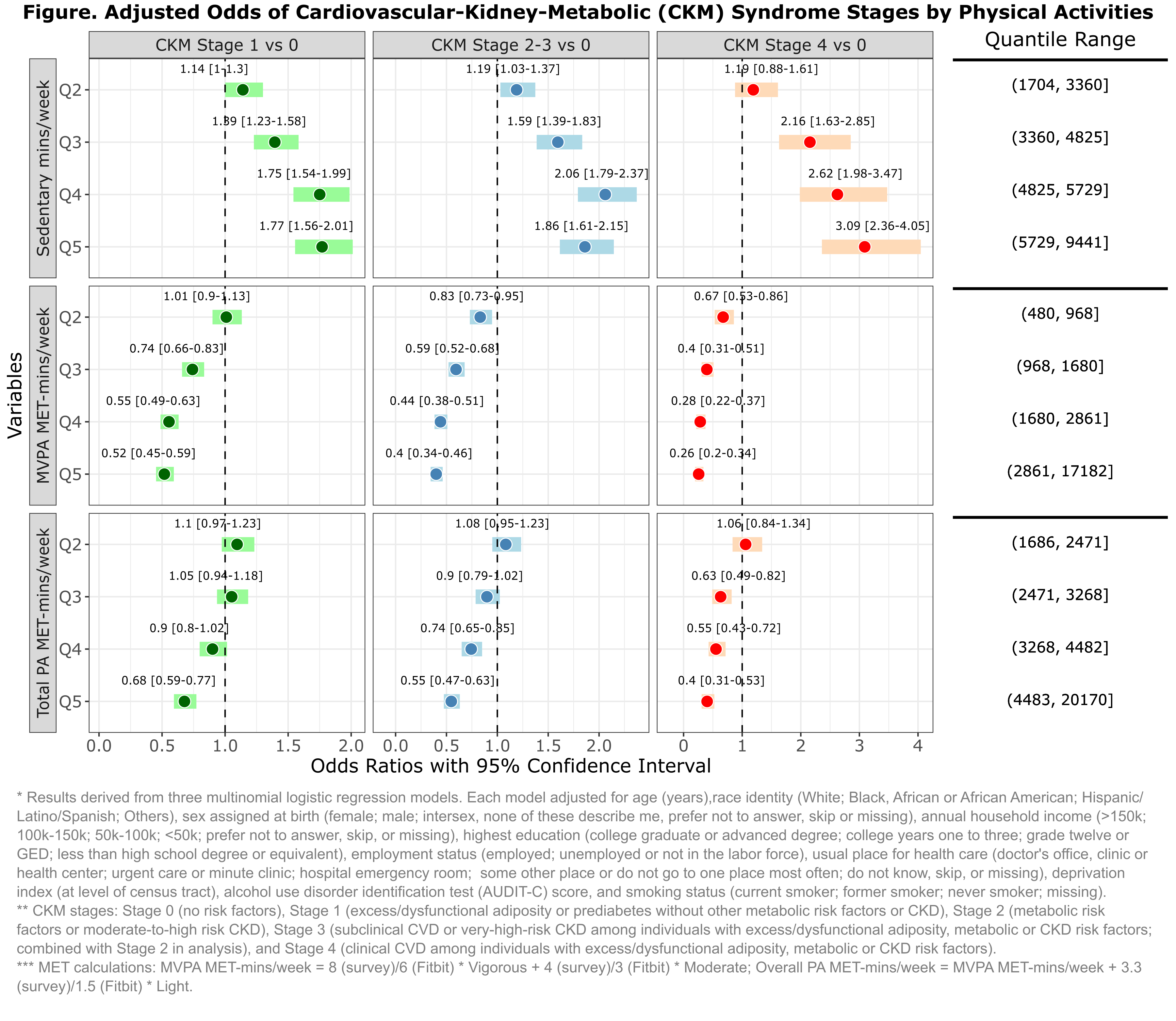Final ID: MP74
Physical Activity Patterns and Cardiovascular-Kidney-Metabolic (CKM) Syndrome: An All of US Research Program Study
Abstract Body: Background: Increased physical activity (PA) benefits cardiovascular, kidney, and metabolic health individually. However, its impact on cardiovascular-kidney-metabolic (CKM) syndrome, which integrates these interconnected disorders, is unknown. This study evaluated the association between PA and CKM syndrome among adults ≤70 years old from a population-based cohort.
Methods: Using data from the National Institutes of Health All of Us Research Program, we defined the outcome, CKM syndrome stages, as follows: stage 0 (no risk factors), stage 1 (excess/dysfunctional adiposity or prediabetes), stages 2-3 (metabolic risk factors, moderated-to-high risk kidney disease, or subclinical cardiovascular disease [CVD]), and stage 4 (clinical CVD). PA was quantified using Fitbit data or self-reported surveys as sedentary mins/week, moderate-to-vigorous PA (MVPA) metabolic equivalent task (MET)-mins/week, and total PA MET-mins/week. Multinomial logistic regression models assessed the association between PA measures in quintiles and CKM syndrome stages, adjusting for demographics, socioeconomic status (individual and neighborhood levels), lifestyle factors and healthcare access.
Results: Among 17,118 adults (mean age 50±13 years, 70% female, 81% White), 48% had CKM syndrome (24% stage 1, 20% stages 2 and 3, 3.9% stage 4). Mean (SD) sedentary mins/week, MVPA MET-mins/week, and total PA MET-mins/week were 4,046 (2,048), 1,670 (1,729), and 3,111 (1,965), respectively. Compared to the lowest quintile, adults in the highest quintile of sedentary time (>5729 vs ≤1704 mins/week) had a significantly higher odds of CKM syndrome across all stages (Figure), with the strongest association for stage 4 (OR 3.09, 95% CI 2.36-4.05). For MVPA, adults in the highest quintile (>2861 vs ≤480 MET-mins/week) had a significantly lower odds of CKM syndrome, most pronounced for stage 4 (OR 0.26, 95% CI 0.20-0.34). Similarly for total PA, the highest quintile (>4483 vs ≤1686 MET-mins/week) was associated with lower odds of CKM syndrome, particularly for stage 4 (OR 0.40, 95% CI 0.31-0.53). Dose-response relationships were observed across all measures and CKM stages.
Conclusion: Exceeding the recommended 500-1000 MET-mins/week of MVPA is associated with a significant CKM Syndrome risk reduction across all stages.
Methods: Using data from the National Institutes of Health All of Us Research Program, we defined the outcome, CKM syndrome stages, as follows: stage 0 (no risk factors), stage 1 (excess/dysfunctional adiposity or prediabetes), stages 2-3 (metabolic risk factors, moderated-to-high risk kidney disease, or subclinical cardiovascular disease [CVD]), and stage 4 (clinical CVD). PA was quantified using Fitbit data or self-reported surveys as sedentary mins/week, moderate-to-vigorous PA (MVPA) metabolic equivalent task (MET)-mins/week, and total PA MET-mins/week. Multinomial logistic regression models assessed the association between PA measures in quintiles and CKM syndrome stages, adjusting for demographics, socioeconomic status (individual and neighborhood levels), lifestyle factors and healthcare access.
Results: Among 17,118 adults (mean age 50±13 years, 70% female, 81% White), 48% had CKM syndrome (24% stage 1, 20% stages 2 and 3, 3.9% stage 4). Mean (SD) sedentary mins/week, MVPA MET-mins/week, and total PA MET-mins/week were 4,046 (2,048), 1,670 (1,729), and 3,111 (1,965), respectively. Compared to the lowest quintile, adults in the highest quintile of sedentary time (>5729 vs ≤1704 mins/week) had a significantly higher odds of CKM syndrome across all stages (Figure), with the strongest association for stage 4 (OR 3.09, 95% CI 2.36-4.05). For MVPA, adults in the highest quintile (>2861 vs ≤480 MET-mins/week) had a significantly lower odds of CKM syndrome, most pronounced for stage 4 (OR 0.26, 95% CI 0.20-0.34). Similarly for total PA, the highest quintile (>4483 vs ≤1686 MET-mins/week) was associated with lower odds of CKM syndrome, particularly for stage 4 (OR 0.40, 95% CI 0.31-0.53). Dose-response relationships were observed across all measures and CKM stages.
Conclusion: Exceeding the recommended 500-1000 MET-mins/week of MVPA is associated with a significant CKM Syndrome risk reduction across all stages.
More abstracts on this topic:
Accelerometer-Measured Physical Activity and Sedentary Behavior and Risks of All-Cause and Cardiovascular Disease Mortality Among Postmenopausal Cancer Survivors: The Women’s Health Accelerometry Collaboration
Hyde Eric, Stefanick Marcia, Skiba Meghan, Crane Tracy, Lee I-min, Lacroix Andrea, Bandoli Gretchen, Zou Jingjing, Crespo Noe, Parada Humberto, Evenson Kelly, Lamonte Michael, Nguyen Steve, Howard Annie Green
An Innovative telemonitoring-wearable device with third heart sound detection for early detection of worsening heart failureMasuda Hirotada, Ekuni Shota, Misumi Yusuke, Akazawa Yasuhiro, Sakata Yasushi, Miyagawa Shigeru

